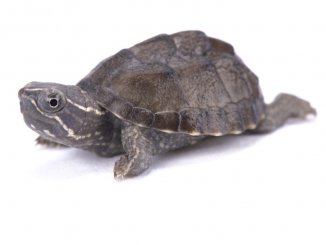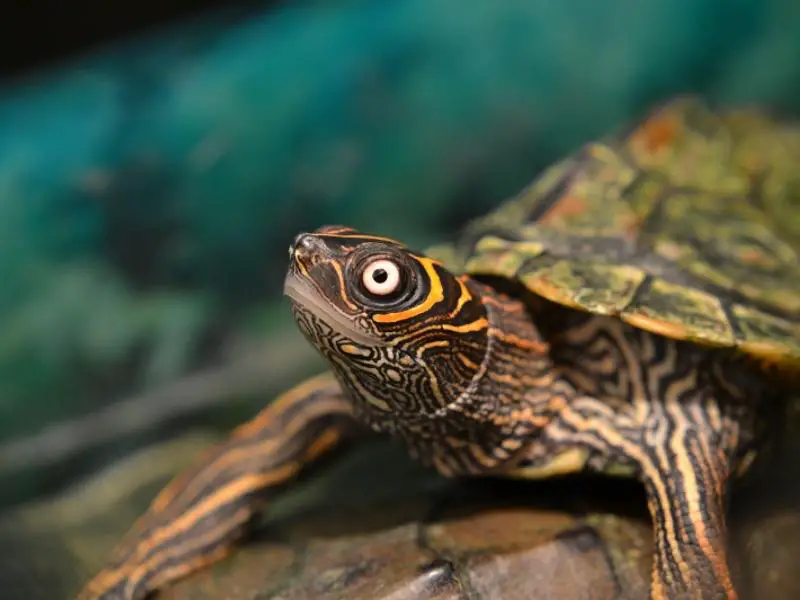
The Mississippi map turtle is endemic to the United States. The reptile is named after its coloring and its natural habitat on the banks of the Mississippi River. Mississippi map turtles are one of the 14 sub-species of the map turtle species group.
Mississippi map turtles are fun but demanding pets. The turtles are best kept by experienced owners and don’t make good pets for children. Pay close attention to the turtle’s health by providing lots of open aquarium space and feeding the turtle the proper diet.
Mississippi Map Turtle Overview
| Common name | Mississippi map turtle |
| Scientific name | Graptemys pseudogeographica kohni |
| Natural habitat | Open bodies of water, including rivers, ponds, and streams |
| Adult size | 10 inches (females) or 5 inches (males) |
| Average lifespan | Over 30 years |
| Diet | Omnivore |
| Housing | 75–125 gallons |
| Experience | Experienced |
Origin
The Mississippi map turtle (Graptemys pseudogeographica kohni) is native to the Mississippi Valley in the United States. The species can also be found as far south as Illinois and Missouri. These reptiles thrive in large bodies of water and large fast-paced rivers and streams.
The first Mississippi map turtles were found in the wild in the mid-19th century in New Orleans, Louisiana. These turtles are also considered an invasive species…
Appearance and Behavior
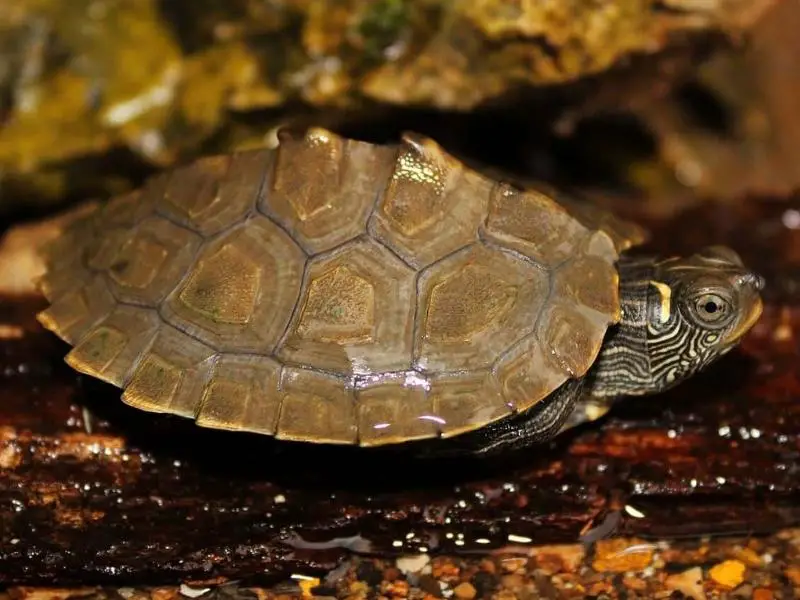
The Mississippi map turtle gets its name from its shell pattern which resembles a map. The Mississippi map turtle is also recognized by the sharp, serrated ridge in the middle of its shell, which gives the tail the nickname “sawback turtle.”
The turtle’s shell is usually yellow, dark green, and brown. The bottom part of the carapace is green or brown with light stripes. The Mississippi map turtle has characteristic bright-yellow circles or crescent-like shapes around its eyes.
The female Mississippi map turtle has a thinner, shorter tail compared to the male’s, and its belly is caved in. The male turtle has larger claws on its legs, and its undershell is concaved.
Size and Lifespan
Mississippi map turtles are medium-sized reptiles. The female turtles tend up to 10 inches in length, double the size of the male.
The Mississippi map turtle is considered a long-living pet. If taken care of properly, this species can live over 30 years in captivity. In the wilderness, these reptiles typically survive between 15 and 20 years.
Temperament
Mississippi map turtles are friendly creatures that can make an excellent addition to a friendly turtle tank. However, female Mississippi map turtles can become more dominant because they’re almost twice as large as an average male. Avoid keeping multiple female Mississippi map turtles in the same aquarium.
A Mississippi map turtle is a timid pet that can be scared easily. When frightened, the turtle dives deep into the water in search of refuge.
It’s best to limit the handling of this species because Mississippi map turtles can become stressed when touched, and might bite. These turtles have strong jaws, so their bite can be rather painful.
Housing Mississippi Map Turtle

The Mississippi map turtle’s natural habitat is represented by fast streams, ponds, and rivers located in the southern part of the United States. These reptiles are strong swimmers and are competent in fast-flowing bodies of water. The turtles prefer staying in the water, only coming out to the land for mating.
Mississippi map turtles thrive in large fish tanks and aquariums of up to 150 gallons. The aquarium needs to be larger for females and can be smaller for males.
Enclosure size
Adult Mississippi map turtles are active reptiles that need a lot of space to swim. For a male turtle, a 75-gallon fish tank is sufficient, and 125 gallons is a good size for a female.
A 75-gallon tank is typically 4 feet long and 1.5 feet wide, and a larger 125-gallon tank is six feet long. The height of the aquarium should be at least 12 inches. A tall tank isn’t necessary for this species because the turtle can’t climb.
Mississippi map turtles are strictly aquatic and need areas in the tank where they can fully submerge themselves in water.
Lighting
Recreate the Mississippi map turtle’s natural lighting in captivity by equipping the turtle’s tank with UVB lighting and heat lamps. Optionally, add regular lights on a day-night timer in addition to the UVB light and heat lamps.
The turtles need to be exposed to UVB lighting for 12 hours every day throughout the year. The UVB lamp shouldn’t be blocked by glass or plastic. The lamp should be installed inside the tank so that the light falls directly on the turtle. Change the UVB bulbs every six to nine months.
Temperature and Humidity
The turtle’s tank should be temperature controlled to have a basking area and a cooler, ambient temperature. Keep the temperature in the basking area between 85ºF and 90ºF, and the temperature in the cooler areas of the tank no lower than 80ºF. If the temperature drops below 65ºF, the turtle will become less active and eventually go into hibernation.
Use a heater in the basking area to maintain the proper temperature. The heater should be located strictly above the basking area.
The temperature of the water in the tank should be around 75ºF. A submersible heater can be used to keep the water temperature levels consistent.
Substrate and Decoration
For the turtle’s basking area, use gravel mixed with larger rocks, or even fine sand, to mimic the banks where the turtle would bask in the wild. Clean the substrate and let it settle before introducing the turtle into the aquarium.
Mississippi map turtles can be startled easily. Add rocks, pieces of wood, and floating accessories to the tank for the turtle to hide by.
Mississippi map turtles are also used to being surrounded by rich vegetation. The tank should have a mix of real and fake plants to mimic the turtle’s natural surroundings.
Cleaning
Mississippi map turtles are messy pets and produce a lot of waste. The turtle’s waste contributes to high ammonia and nitrate levels in the tank water and facilitates quick algae growth, which makes the aquarium harder to clean and can eventually harm the turtle’s health.
The best way to keep the turtle’s tank clean is with a powerful filter. A filter will ensure that the quality of water in the tank is stable, leaving the owner to perform water changes once every two weeks. The enclosure should be fully cleaned once every three months.
Mississippi Map Turtle Care
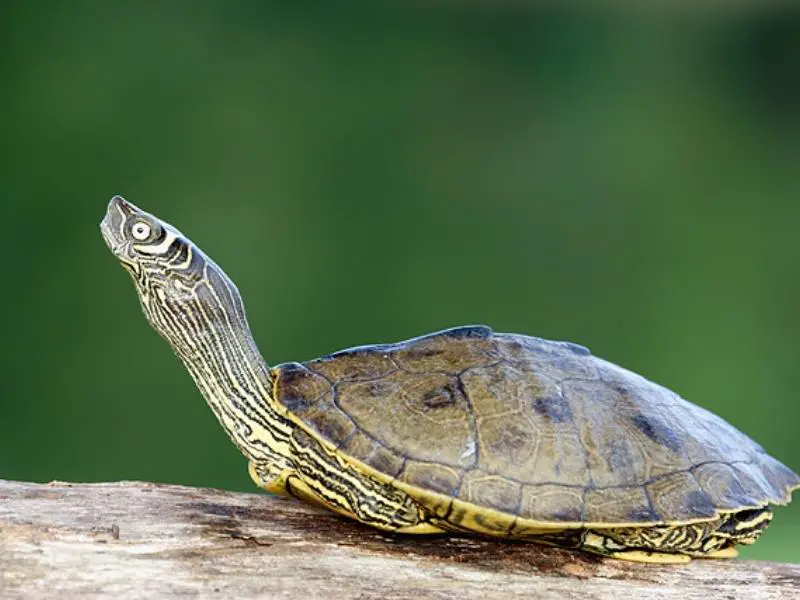
The Mississippi map turtle is a demanding pet that requires a highly experienced owner. It’s best to avoid buying this turtle as a pet for a child. A Mississippi map turtle needs a strict hygiene routine, a varied diet, and highly specific conditions in the tank.
Food and Water
Mississippi map turtles are an aquatic species that feed exclusively in water. Pet turtles should be fed four to five times every week. To prevent Mississippi map turtles from becoming obese, give them a variety of foods to choose from and feed just enough for the turtle to eat within two to three minutes. The best time to feed the turtle is in the morning or afternoon when the turtle is most active.
Mississippi map turtles are omnivores and their diets in captivity should consist of a combination of plants and protein-rich animals. Include dark leafy greens like dandelion leaves, romaine lettuce, and parsley, as well as aquatic turtle pellets, small insects, crustaceans, and freeze-dried shrimp or fish bits.
Females have larger jaws than males and can eat food as large as a small snail. Males should eat foods smaller than this, such as chopped crickets, mealworms, and small pieces of fish. Mississippi map hatchlings should be fed every day for the first six months, with diet turtle pellets and leafy greens.
Mississippi map turtles don’t need a separate water bowl in their tanks because they drink the water they swim in.
Handling
The Mississippi map turtle is an extremely skittish animal that doesn’t enjoy being handled. Too much handling of this turtle will stress it and may have long-term consequences for its health.
Mississippi map turtles should only be handled when necessary, for instance when the tank is being cleaned. When touching the turtle, make sure to do so as slowly and as gently as possible to decrease stress. Lift the Mississippi map turtle with both hands by holding the bottom of the shell.
Move the Mississippi map turtle to a separate container or a small tank to clean the home tank. Don’t leave the turtle to wander the house. Large, unfamiliar places without familiar hiding spots can stress the turtle.
Common Health Issues
Mississippi map turtles are considered healthy and they rarely experience major health issues. However, reptile keepers should watch the turtle’s health closely and respond right away when they notice early signs of poor health. Some of the diseases common among these sub-species are difficult to cure.
Parasites
Like many reptiles, Mississippi map turtles suffer from intestinal parasites. Uncontrolled parasitic infections can become a serious threat to the turtle’s health. Avoid taking home as a pet a Mississippi map turtle that has parasites by reviewing the results of the turtle’s last annual exam with an exotic veterinary expert.
Water Contamination
Poor-quality water in the aquarium leads to certain health risks for the Mississippi map turtle including skin, ear, and shell infections.
An ear infection is easy to recognize by a noticeable bump behind the turtle’s eye. A veterinarian should clean the infection and treat it with antibiotics.
Flaky skin and unusual-colored spots on the skin are both signs of a skin infection. Turtles with skin infections should see the animal to the vet and be treated with prescribed medication.
A shell infection is caused by too much algae in the tank. If the algae cover the turtle’s shell, clean the shell with a soft toothbrush.
Malnutrition
A poor diet and a lack of proper UVB lighting may lead to calcium deficiency in the turtle, resulting in metabolic bone disease that manifests as shell deformity. This disease is very hard to treat and is better prevented by ensuring that the tank has proper lighting and the turtle receives the proper diet.
Breeding
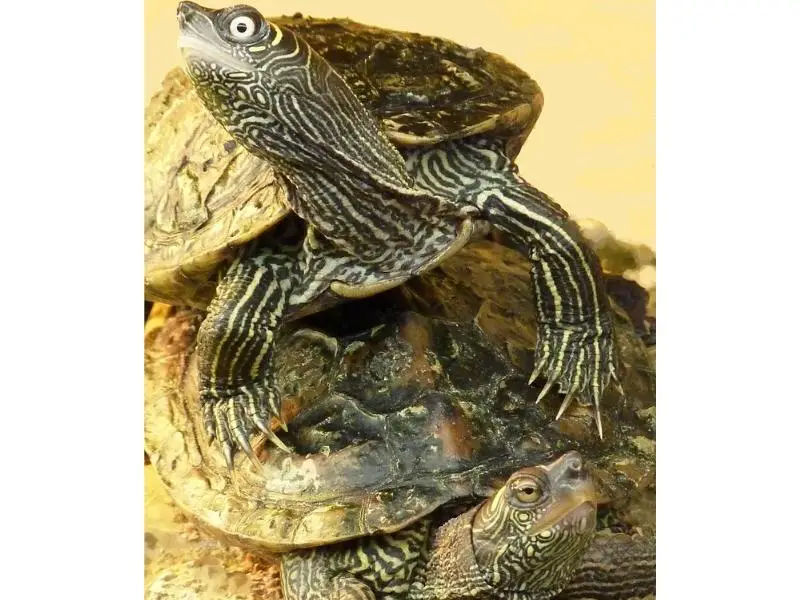
Breeding Mississippi map turtles in captivity don’t require special conditions. A male and female pair housed together may eventually breed if the tank conditions are optimal. Male turtles are more sexually active than females during the breeding period. The ideal male-to-female ratio for breeding these turtles is two males for five females.
Mississippi map turtles mate twice a year — once in spring and once in fall. If the turtles are matched and the female accepts the male, after two to three weeks from successful mating, the female will lay eggs in the nesting area. A nesting box should be at least 12 inches wide for the turtle to be able to turn and 8 inches deep for the animal to be able to dig a deep hole for the eggs. Make sure that the nesting box is layered with a damp soil mixture for the female to be able to hide the eggs. After the eggs are laid, remove the male from the enclosure.
The eggs should be incubated at a temperature of 84oF. The eggs will hatch after around 60 days.
Choosing and Buying a Mississippi Map Turtle
Mississippi map turtles cost between $20 and $100, depending on the turtle’s age, its health conditions, and the reputation of the breeder. These turtles are common in the US and can be found in a variety of pet stores.
When purchasing a Mississippi map turtle, make sure the animal doesn’t have flaky or irritated skin, irregular bumps on its shell or head, or cloudy eyes. Look at the turtle in person before taking it home as a pet. Avoid buying a turtle with underlying health problems by buying from a reputable breeder and by buying a turtle that has a known clear medical health history.


